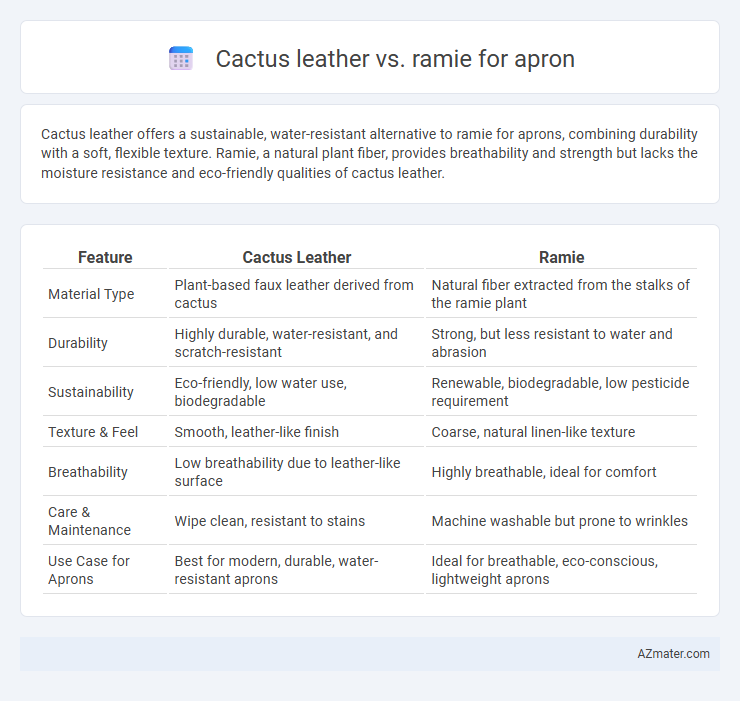Cactus leather offers a sustainable, water-resistant alternative to ramie for aprons, combining durability with a soft, flexible texture. Ramie, a natural plant fiber, provides breathability and strength but lacks the moisture resistance and eco-friendly qualities of cactus leather.
Table of Comparison
| Feature | Cactus Leather | Ramie |
|---|---|---|
| Material Type | Plant-based faux leather derived from cactus | Natural fiber extracted from the stalks of the ramie plant |
| Durability | Highly durable, water-resistant, and scratch-resistant | Strong, but less resistant to water and abrasion |
| Sustainability | Eco-friendly, low water use, biodegradable | Renewable, biodegradable, low pesticide requirement |
| Texture & Feel | Smooth, leather-like finish | Coarse, natural linen-like texture |
| Breathability | Low breathability due to leather-like surface | Highly breathable, ideal for comfort |
| Care & Maintenance | Wipe clean, resistant to stains | Machine washable but prone to wrinkles |
| Use Case for Aprons | Best for modern, durable, water-resistant aprons | Ideal for breathable, eco-conscious, lightweight aprons |
Introduction: Sustainable Apron Materials
Cactus leather offers a vegan, biodegradable alternative to traditional leather, crafted from mature cactus leaves with minimal water usage, making it an eco-friendly choice for apron production. Ramie, a natural plant fiber known for its durability and breathability, requires fewer pesticides and less water than cotton, contributing to a lower environmental impact. Both materials align with sustainable fashion trends by reducing resource consumption and promoting biodegradable textiles in apron manufacturing.
What is Cactus Leather?
Cactus leather is an innovative, eco-friendly material derived from mature leaves of the nopales cactus, processed to create a durable, flexible alternative to traditional animal leather. It offers water resistance, biodegradability, and a naturally textured surface that enhances apron aesthetics and longevity. Compared to ramie, a plant-based fiber valued for its breathability and strength, cactus leather provides superior water repellency and a more leather-like finish, making it ideal for aprons requiring both style and functional durability.
What is Ramie?
Ramie is a natural fiber derived from the stalks of the Chinese nettle plant, renowned for its exceptional strength and durability, making it a sustainable choice for apron fabrics. Unlike cactus leather, which mimics animal leather with a plant-based alternative, ramie offers breathability and natural resistance to wrinkles and mildew. This makes ramie aprons ideal for long-term use in kitchens and workshops where durability and comfort are essential.
Environmental Impact: Cactus Leather vs Ramie
Cactus leather, made from the mature leaves of the Nopal cactus, is a sustainable alternative that requires minimal water and no pesticides, significantly reducing its environmental footprint compared to traditional leather. Ramie, derived from the fibers of the Boehmeria plant, is a biodegradable natural fiber that grows quickly with low water usage and requires little chemical processing. Both materials offer eco-friendly options for aprons, but cactus leather's lower water consumption and renewable cultivation give it a notable advantage in reducing environmental impact.
Durability and Longevity Comparison
Cactus leather offers superior durability and resistance to wear compared to ramie, making it ideal for heavy-duty aprons exposed to frequent use and harsh conditions. Ramie, while strong and breathable, tends to degrade faster under constant abrasion and moisture, reducing its longevity in demanding environments. The natural resilience and water-resistant properties of cactus leather ensure a longer lifespan and sustained performance for aprons.
Comfort and Breathability
Cactus leather offers a unique combination of durability and softness, but it tends to be less breathable compared to natural fibers, which can affect comfort during prolonged wear. Ramie, a natural plant-based fiber, excels in breathability and moisture-wicking properties, making it ideal for aprons that require extended use in warm or humid environments. For optimal comfort and airflow in aprons, ramie outperforms cactus leather by providing a cooler, more breathable fabric.
Maintenance and Care Requirements
Cactus leather requires minimal maintenance, needing only occasional wiping with a damp cloth to remove dirt and prevent cracking, and it is naturally water-resistant, making it ideal for aprons exposed to moisture. Ramie aprons demand more frequent washing to maintain fabric integrity, preferably hand washing or gentle machine cycles to avoid weakening the natural fibers, and should be air-dried to prevent shrinkage. Both materials benefit from avoiding harsh chemicals or prolonged sun exposure, preserving durability and appearance over time.
Style and Aesthetic Differences
Cactus leather offers a sleek, modern appearance with a smooth texture and subtle natural grain, making aprons crafted from it ideal for contemporary and minimalist styles. Ramie fabric, derived from a natural plant fiber, presents a rustic, woven texture providing a more organic, vintage aesthetic that complements bohemian and traditional designs. The choice between cactus leather and ramie for aprons hinges on whether a polished, sophisticated look or a textured, earthy vibe is desired.
Cost Analysis: Cactus Leather vs Ramie Aprons
Cactus leather aprons generally have a higher cost due to their sustainable production process and durability compared to ramie aprons, which are more affordable as they are made from natural plant fibers with less processing. The price of cactus leather aprons ranges from $50 to $120, while ramie aprons typically cost between $20 and $60, reflecting differences in material sourcing and manufacturing complexity. Investing in cactus leather aprons offers longer lifespan and eco-friendly benefits, whereas ramie aprons provide a budget-friendly option with moderate durability.
Choosing the Best Material for Your Apron
Cactus leather offers superior water resistance and durability, making it ideal for aprons used in wet or heavy-duty environments, while ramie provides exceptional breathability and natural antimicrobial properties suited for lightweight, eco-friendly aprons. Cactus leather's sustainability stems from its low water usage and fast-growing nature, whereas ramie, a bast fiber derived from the stalks of the Ramie plant, excels in moisture wicking and biodegradability. Choosing between cactus leather and ramie hinges on your apron's primary function: durability and water resistance favor cactus leather, while comfort and environmental impact lean toward ramie.

Infographic: Cactus leather vs Ramie for Apron
 azmater.com
azmater.com